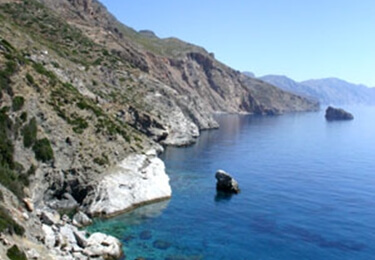 The oblong shape of the mountainous and barren island of Amorgos lies on the eastern edge of the Cyclades, almost in the Dodecanese. In some places, the coastline is steep and rocky, while elsewhere it forms quiet, shady bays. The remains found all over the island and the important archaeological finds discovered there (some of which are in the National Archaeological Museum, Athens), are testimony to the fact that Amorgos was inhabited in prehistoric times and was a place of great importance during the period of the Cycladic civilization.
The oblong shape of the mountainous and barren island of Amorgos lies on the eastern edge of the Cyclades, almost in the Dodecanese. In some places, the coastline is steep and rocky, while elsewhere it forms quiet, shady bays. The remains found all over the island and the important archaeological finds discovered there (some of which are in the National Archaeological Museum, Athens), are testimony to the fact that Amorgos was inhabited in prehistoric times and was a place of great importance during the period of the Cycladic civilization.
Greece
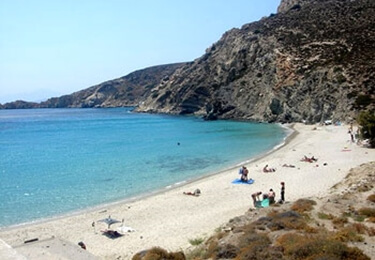 Donousa is part of the Lesser East Cyclades, residing on the far eastern site of the complex. Not much is known about these islands. Most of them including Donousa where inhabited during the prehistoric times and later became vital parts of the Cycladic Civilization.
Donousa is part of the Lesser East Cyclades, residing on the far eastern site of the complex. Not much is known about these islands. Most of them including Donousa where inhabited during the prehistoric times and later became vital parts of the Cycladic Civilization.
During the Roman Era Donousa was a place of exile, while during the middle ages, it served, among others, as a Pirate hide-out. Like all islands in Cyclades Donousa is known for its beautiful surroundings and sandy beaches.
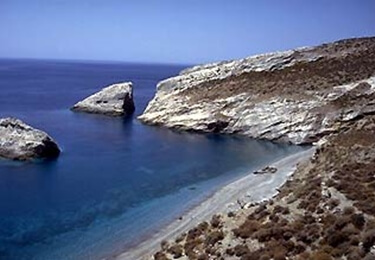 Folegandros is a small and rocky island between Sikinos and Milos. Visitors will be struck by the wild beauty of the barren landscape, where huge rocks alternate with sandy beaches. On a flat expanse above the pretty harbour of Karavostasi is Hora or Folegandros, which consists of two section. In the old settlement in the Kastro area, the outer walls of the houses form the sort of defensive precinct to be found else where in the Cyclades.
Folegandros is a small and rocky island between Sikinos and Milos. Visitors will be struck by the wild beauty of the barren landscape, where huge rocks alternate with sandy beaches. On a flat expanse above the pretty harbour of Karavostasi is Hora or Folegandros, which consists of two section. In the old settlement in the Kastro area, the outer walls of the houses form the sort of defensive precinct to be found else where in the Cyclades.
 Ios is one of the most picturesque islands of Cyclades. The coastline of this predominantly mountainous island with its countless chapels, its olive trees, its vineyards and its limpid air, is adorned with small, attractive coves. Tradition claims that this is the island where the tomb of the poet Homer lies. Beautiful beaches are not unusual on this island.
Ios is one of the most picturesque islands of Cyclades. The coastline of this predominantly mountainous island with its countless chapels, its olive trees, its vineyards and its limpid air, is adorned with small, attractive coves. Tradition claims that this is the island where the tomb of the poet Homer lies. Beautiful beaches are not unusual on this island.
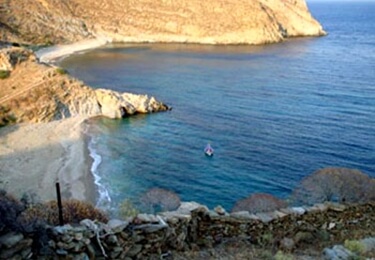 The island is mostly barren with patches of cultivated and wooded ground near the coast. The lyric poets Simonides and Bacchlides come from this island. The picturesque hamlet of Vourkari is most popular and has excellent restaurants.
The island is mostly barren with patches of cultivated and wooded ground near the coast. The lyric poets Simonides and Bacchlides come from this island. The picturesque hamlet of Vourkari is most popular and has excellent restaurants.
The large protected bay was once important as a coaling station for steamers. The beautiful 'Chora' on the hill, a huddle of glaring white houses, is well worth a visit. A large lion carved from the rock face is attributed to an Ionian sculptor from around 600 BC.
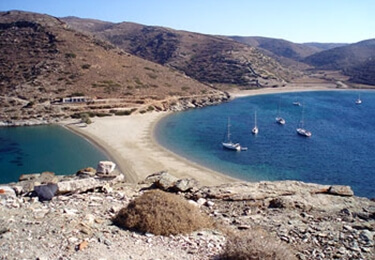 Kythnos is a typical island of the Cyclades. Two of its villages and the capital ("Chora") are spread on the hills with their two-story houses covered with red tiles. Golden beaches, easily accessible, invite the visitors for a quiet relaxing vacation.
Kythnos is a typical island of the Cyclades. Two of its villages and the capital ("Chora") are spread on the hills with their two-story houses covered with red tiles. Golden beaches, easily accessible, invite the visitors for a quiet relaxing vacation.
The Loutra resort has warm sulphurous spa-waters. The tradition says that the water comes undersea from Vesuvious and the springs have been used since ancient times -and still are used- as a cure from rheumatism.
 It's the tourist Mecca of Greece. Mykonos is bright and breezy with fine sandy beaches by day and by night the hum of the bars and throb of discos into the wee hours is all part of the scene. It is the island where locals and plain ordinary holidaymakers rub shoulders with the yacht set, jet set, artists and celebrities from all over the world.
It's the tourist Mecca of Greece. Mykonos is bright and breezy with fine sandy beaches by day and by night the hum of the bars and throb of discos into the wee hours is all part of the scene. It is the island where locals and plain ordinary holidaymakers rub shoulders with the yacht set, jet set, artists and celebrities from all over the world.
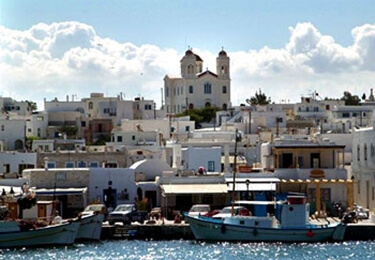 It's a popular tourist island, known for its golden beaches and its prime example of Cycladic architecture. Churches, shops and houses, dazzling white cubes with bougainvillias and wisteria providing splashes of natural color against the deep blue of the Aegean. Paros possesses the finest churches in the region, the most famous being the Ekatontapiliani which is well worth a visit for the beautiful interior.
It's a popular tourist island, known for its golden beaches and its prime example of Cycladic architecture. Churches, shops and houses, dazzling white cubes with bougainvillias and wisteria providing splashes of natural color against the deep blue of the Aegean. Paros possesses the finest churches in the region, the most famous being the Ekatontapiliani which is well worth a visit for the beautiful interior.
Popular News
Latest News
Contact us
92 Dimokratias Str. PC175 63
P. Faliro, Athens, Greece
Tel : +30 210 9824611
Mob : +30 6977009563
Fax : +30 210 9849.972
Email: info@aegean-cruises.gr
